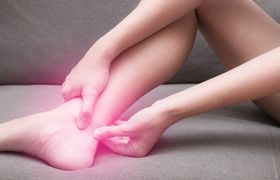What Are the Benefits of Eccentric Heel Raises?
Eccentric heel raises are a low-impact exercise that promises many benefits. Learn how it may help Achilles Tendonitis and prevent other inflammatory conditions.
Published August 31, 2021
Eccentric heel raises are a low-impact exercise that anyone can perform with only a box or stair to stand on.
How to do eccentric heel raises:
- Place the balls of your feet on the raised surface.
- Lift your heels up.
- Shift your weight onto one foot.
- Lower your working heel as slowly as possible and as far as you can below the raised surface.
As you can see, the exercise is simple, but it poses a number of different benefits.
Prevention and Treatment of Achilles Tendonitis
Athletes, especially runners, are at risk for developing a painful condition called Achilles tendonitis. It is an overuse injury that manifests symptoms such as mild to severe pain in the back of the leg or above the heel or even unusual tenderness, stiffness, or irritation in the Achilles tendon.
Performing eccentric heel raises regularly can help strengthen the Achilles tendon and prevent this condition from occurring. Additionally, performing these exercises can also assist in the healing process if you already suffer from this condition.
Eccentric Heel Raises Strengthen the Calf Muscles
By working the same muscles as concentric calf raises, eccentric heel raises can strengthen the calf muscles and help prevent a number of injuries.
Weak calf muscles can sometimes be a contributing factor to the painful condition known as plantar fasciitis, and so by performing this exercise, you can both prevent and treat many inflammatory conditions that form in the feet and legs.
When Should You Start Eccentric Heel Raises?
Technically, there is no right or wrong time to start incorporating eccentric heel raises into your routine. Starting immediately can help prevent a number of painful inflammatory conditions and strengthen weak muscles. At the same time, you can also incorporate them into a treatment plan to give your Achilles tendon or plantar fasciitis pain some relief.
Related Articles

Can Orthotic Insoles Help Treat Achilles Tendonitis?
Dr. Pooja Gajare
March 24, 2023

Overpronation vs. Underpronation: Similarities and Differences
Babafemi Adebajo
February 15, 2023

Secondary Conditions Associated With Flat Feet
Babafemi Adebajo
January 30, 2024

FSA Eligible: Buy Custom Orthotics With Your FSA Funds
Babafemi Adebajo
December 9, 2024

Do You Have Shin Splints? Learn How to Test Yourself at Home
Janik Sundstrom
August 30, 2025
Related Posts
Babafemi Adebajo
How Do You Perform Eccentric Heel Raises Correctly?
Babafemi Adebajo
Do Heel Cups Help Achilles Tendonitis
Babafemi Adebajo
Can You Run With Achilles Tendonitis?
Dr. Pooja Gajare
Can Orthotic Insoles Help Treat Achilles Tendonitis?
Babafemi Adebajo



